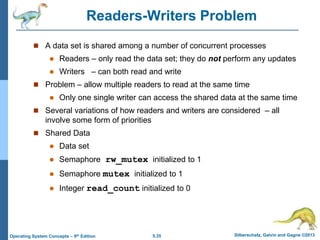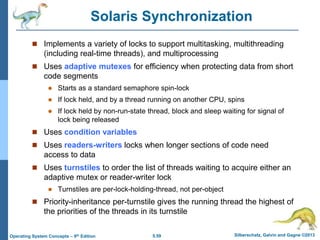This document summarizes chapter 5 from the textbook "Operating System Concepts - 9th Edition" which covers process synchronization. It introduces the critical section problem where multiple processes need synchronized access to shared resources. Peterson's algorithm is presented as a solution using shared variables to coordinate access between two processes. The chapter also discusses synchronization tools like mutex locks and semaphores that can be used to solve critical section problems in a way that is accessible to application programmers.




![5.5 Silberschatz, Galvin and Gagne ©2013
Operating System Concepts – 9th Edition
Producer
while (true) {
/* produce an item in next produced */
while (counter == BUFFER_SIZE) ;
/* do nothing */
buffer[in] = next_produced;
in = (in + 1) % BUFFER_SIZE;
counter++;
}](https://image.slidesharecdn.com/ch5-lecture-8-9-240223150821-449be599/85/Operating-System-Process-Synchronization-5-320.jpg)
![5.6 Silberschatz, Galvin and Gagne ©2013
Operating System Concepts – 9th Edition
Consumer
while (true) {
while (counter == 0)
; /* do nothing */
next_consumed = buffer[out];
out = (out + 1) % BUFFER_SIZE;
counter--;
/* consume the item in next consumed */
}](https://image.slidesharecdn.com/ch5-lecture-8-9-240223150821-449be599/85/Operating-System-Process-Synchronization-6-320.jpg)






![5.13 Silberschatz, Galvin and Gagne ©2013
Operating System Concepts – 9th Edition
Peterson’s Solution
Good algorithmic description of solving the problem
Two process solution
Assume that the load and store machine-language
instructions are atomic; that is, cannot be interrupted
The two processes share two variables:
int turn;
Boolean flag[2]
The variable turn indicates whose turn it is to enter the critical
section
The flag array is used to indicate if a process is ready to enter
the critical section. flag[i] = true implies that process Pi is
ready!](https://image.slidesharecdn.com/ch5-lecture-8-9-240223150821-449be599/85/Operating-System-Process-Synchronization-13-320.jpg)
![5.14 Silberschatz, Galvin and Gagne ©2013
Operating System Concepts – 9th Edition
Algorithm for Process Pi
do {
flag[i] = true;
turn = j;
while (flag[j] && turn = = j);
critical section
flag[i] = false;
remainder section
} while (true);](https://image.slidesharecdn.com/ch5-lecture-8-9-240223150821-449be599/85/Operating-System-Process-Synchronization-14-320.jpg)
![5.15 Silberschatz, Galvin and Gagne ©2013
Operating System Concepts – 9th Edition
Peterson’s Solution (Cont.)
Provable that the three CS requirement are met:
1. Mutual exclusion is preserved
Pi enters CS only if:
either flag[j] = false or turn = i
2. Progress requirement is satisfied
3. Bounded-waiting requirement is met](https://image.slidesharecdn.com/ch5-lecture-8-9-240223150821-449be599/85/Operating-System-Process-Synchronization-15-320.jpg)























![5.40 Silberschatz, Galvin and Gagne ©2013
Operating System Concepts – 9th Edition
Dining-Philosophers Problem
Philosophers spend their lives alternating thinking and eating
Don’t interact with their neighbors, occasionally try to pick up 2
chopsticks (one at a time) to eat from bowl
Need both to eat, then release both when done
In the case of 5 philosophers
Shared data
Bowl of rice (data set)
Semaphore chopstick [5] initialized to 1](https://image.slidesharecdn.com/ch5-lecture-8-9-240223150821-449be599/85/Operating-System-Process-Synchronization-39-320.jpg)
![5.41 Silberschatz, Galvin and Gagne ©2013
Operating System Concepts – 9th Edition
Dining-Philosophers Problem Algorithm
The structure of Philosopher i:
do {
wait (chopstick[i] );
wait (chopStick[ (i + 1) % 5] );
// eat
signal (chopstick[i] );
signal (chopstick[ (i + 1) % 5] );
// think
} while (TRUE);
What is the problem with this algorithm?](https://image.slidesharecdn.com/ch5-lecture-8-9-240223150821-449be599/85/Operating-System-Process-Synchronization-40-320.jpg)







![5.49 Silberschatz, Galvin and Gagne ©2013
Operating System Concepts – 9th Edition
Monitor Solution to Dining Philosophers
monitor DiningPhilosophers
{
enum { THINKING; HUNGRY, EATING) state [5] ;
condition self [5];
void pickup (int i) {
state[i] = HUNGRY;
test(i);
if (state[i] != EATING) self[i].wait;
}
void putdown (int i) {
state[i] = THINKING;
// test left and right neighbors
test((i + 4) % 5);
test((i + 1) % 5);
}](https://image.slidesharecdn.com/ch5-lecture-8-9-240223150821-449be599/85/Operating-System-Process-Synchronization-48-320.jpg)
![5.50 Silberschatz, Galvin and Gagne ©2013
Operating System Concepts – 9th Edition
Solution to Dining Philosophers (Cont.)
void test (int i) {
if ((state[(i + 4) % 5] != EATING) &&
(state[i] == HUNGRY) &&
(state[(i + 1) % 5] != EATING) ) {
state[i] = EATING ;
self[i].signal () ;
}
}
initialization_code() {
for (int i = 0; i < 5; i++)
state[i] = THINKING;
}
}](https://image.slidesharecdn.com/ch5-lecture-8-9-240223150821-449be599/85/Operating-System-Process-Synchronization-49-320.jpg)
















